Interview: White Lie’s Gabriel de Lima Carioca
Ambize Studio‘s tale of Greg, a plush bunny looking for his owner, pulls players in with stylized graphics and keen attention to emotional truth. Based in São Paulo, Brazil, the studio explores new art and narrative styles, which is why I was excited to chat with developer Gabriel de Lima Carioca.
Erik Meyer: White Lie follows a rabbit through a sepia-tone landscape, which creates a childlike and fantastic mood for players. As developers, what do you have as goals for the game look/feel, and how do you see the various art/music elements achieving that end?
Gabriel de Lima Carioca: We want the game to represent the loneliness in Greg’s life. That is the main reason for the sepia tone, and we are working with two aspects to add to this point. One of them is the negative space: we want to create this feeling of holding on to what you have and being overwhelmed by your surroundings, creating this tension with your comfort zone. Some scenarios will be oppressive, scary, and will try to subdue you. This will also be reflected in the character animations and how he reacts to his surroundings, creating this feeling of overcoming fears for the chance of being reunited with his owner.
The second one is dichotomy: by working with contrasting elements, we want to create conflicts in Greg’s life. While trying to understand that you can’t change what already happened, you will have to learn and do what you can. You can only change what is in your grasp, not the past. The first journey will be about leaving this zone of being depressed and subdued by your feelings and going on a journey to find answers and change your current situation. This will not be reflected only in the art, but in the narrative as well, showing mementos of the past in the present, the passing of time, the time you lived with Emma, and now that she is gone and you don’t know where, your memories as they effect reality.
Besides that, since we are picturing memories of his past life with his owner, we will explore some objects common to her childhood. A lot of the memories will have an interface specific to the object holding it. If you remember a book Emma read to you a long time ago, the gameplay in that scene will be above a pop-up book. When remembering her telescope and dream about being an astronomer, the interface will resemble the space and have a lot of stars. A lot of the game will have a nostalgic feeling when exploring memories inside the precious mementos of our characters’ lives together.
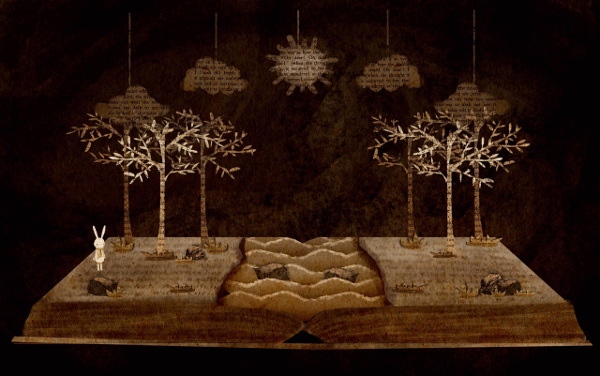
EM: Your team met at BEPiD, an IOS development program at Instituto Eldorado Campinas and has taken part in the Core Labs Game Accelerator program; how have these common experiences effected your project?
GLC: For BEPiD, we learned how to start a project, how to do research, how to create a concept for a game and refine it, and how to start making it into a real product. It was also where we had our first team experience with the current people working at Ambize Studio, and where our team first came together and worked on a game project. For the Core Labs Game Accelerator, it was good on have mentoring about the business and marketing side of game development, how to proper manage a team, how to think of the company in the long term, and some aspects of the development pipeline itself. It was also a good opportunity to contact relevant people in the industry and get to know some who could help us in the future, through advices or partnerships.
EM: Emotional stories call for different kinds of writing from other kinds of fiction and often tug at heartstrings, nostalgia, and other deeply-held aspects of personhood. What do you see as essential, from a literary standpoint, as you write and polish your narrative?
GLC: What I found to be the most complicated aspect of this kind of writing is creating conflicts. I can’t say that what happened in my childhood will resonate with players memories. I can’t be sure that they think the same way as I do about it. So it’s hard to create conflicts to make the story advance, making things that will not be too cliché and will get the player feeling what we want him/her to feel. What helps me have inspiration for writing this kind of stuff is searching for pieces of art, specially on DeviantArt, from some artists who created beautiful concepts of a girl in a contemplative moment, works that evoke a lot of feelings, the likes of those created by sugarmints.

EM: What have been the big challenges as you’ve created assets (animations, artwork, scenes, code, etc); what has taken the majority of your time? What keeps you up at night?
GLC: The majority of our time is taken creating art for the scenarios and animations. Since we are creating a new style, and new interfaces for every memory, we have to spend some time studying what we want and what we will do to create a scenario with the feeling we want to inspire. What elements it will have, how will they be, will this memory be divided on levels, or will it be a continuous scene? How will we make the transition from one scene to another? What animation do we need to plan for that? And on the scenario itself, we need to think on what to animate, where to insert wind, how to make the game feel alive, and since we are creating it with 2D techniques, a lot of things have to be drawn from scratch. What has taken the majority of our time was deciding what to do with the art for each scenario and creating all the needed animations, frame by frame.
EM: You’ve taken White Lie to game events and shared it with the public on social media, so describe how this part of the journey has been for you, as a team. What kinds of coordination has come with presenting your work to the world, and what kinds of responses have you found informative?
GLC: We’ve taken the game to some events, and there are two different moments on our development cycle. The first time we did that was just after the BEPiD program, so we only had what we’d developed there so far. It was focused on mobile, and we were not good at designing mobile interactions, so some people liked the puzzles, some didn’t, but the game felt odd. After that, we were able to restart the game and make decisions based on what we really wanted the game to be, not on what was needed as a deliverable. From this point, we developed our demo and took it to an event for the first time last week. It had a better reception; everyone liked the art, the sound, and the feelings they experienced playing the game. You still can’t understand much of the story, but you can feel some of the character’s loneliness. Some people even cried. And that was an amazing experience. Some people went to our stand specifically looking for us (some of them were press), some people went by referral of friends who had played at an earlier day of the event, and some were intrigued by what they saw on the exhibition website about our game. And it was incredible to find out that there were people following us and anxiously waiting for the development of White Lie.
It was also good to get feedback on some design decisions; some things were not working well, which we noticed right away, and we are making the needed changes for the game to be more intuitive in some parts. We could also see where people get more or less interested while playing, what sell the games to them, and what we need to make better for the release of the game. As a specific example, there is a scene where you are walking over a book, and on the first page, on the right edge of the book, there is a sign with a right arrow. People were supposed to interact with it to change to the next page, but the majority of people followed the arrow and jumped out of the book. So we are thinking on what we could draw inside the sign to make it more intuitive.
But another aspect of this kind of exhibition is getting in touch with other game developers. It was an amazing experience, getting to know some other great games, making new friends, and seeing how we can help each other to make the game industry in our country better than it is now.
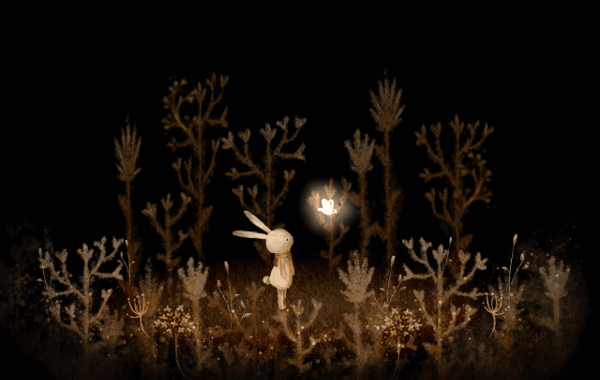
EM: The game contrasts light and dark areas, creating open spaces and specific areas of focus, so I’m interested in your philosophy on layout and the flow of scenes. What helps guide players the most, and what do you find most satisfying as you progress through adventure games?
GLC: What helps guide players the most is the narrative. There are a lot of visual clues, but they only make sense when you hear what the character is saying, what story he is narrating now, how the scenario interacts with your past. That is what helps the player focus on what he needs to interact.
What I find most satisfying as I progress through adventure games is being able to see the story advance. Getting to know the characters motivations, seeing the story go up and down on a rollercoaster of feelings, seeing the character overcome himself/herself, and discovering a meaning behind all my interactions. The most satisfying game I’ve ever played was What Remains of Edith Finch. It was amazing to see all those different stories and be surprised by every one of them, even knowing it was a game about dead people. That game brought so many feelings and it made me feel so immersed, it was satisfying getting to the ending, passing through all the tales, and seeing a meaning in all the house exploration.
EM: Describe your overall team dynamic and take me through the creation of an asset, from genesis to completion. Who is involved, and how does everyone interact? What quirks does Ambize Studio have that set it apart?
GLC: I’ll use the scenario used to tell a memory as example:
It starts with the narrative. For every memory, there is a written page of Emma’s journal telling about it, how she felt, what it meant to her, who was involved, and why some decisions were made. The point of view, seen by Greg, is built by his relationship with Emma, so we need this page as a lens. From this point, we think on interactions and a general flow for the memory, and from that, our art director creates a storyboard. Here, we have our animator plan animations for the environment, transitions, and specific movements for the interactions, and our programmer starts to work on mechanics for those interactions. We start to create the assets for the scenario and the character animations, putting them together in the engine. After that, we finish the environment and transitions animations and start to polish the mechanics, numbers, timings, constraints…
The thing that sets us apart is that, since we have different feelings for different memories, we don’t use the same process every time. Sometimes we need to build things physically and film it, sometimes we need to experience new things, read new books, see new cartoons. And it is very satisfying seeing all these efforts coming together in a level for our game, making the player feel something and seeing his/her reaction.
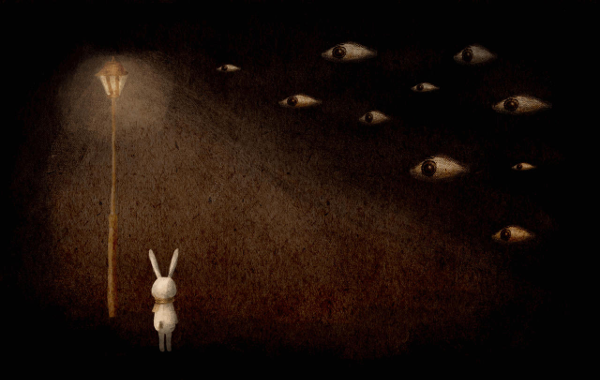
EM: As you continue to develop the project and look towards release, how do you see White Lie in the context of other adventure game titles? What stands out as the most novel elements, and where are you still fleshing things out?
GLC: I hope to see it together with games that are changing the adventure scenario, like Night in the Woods, What Remains of Edith Finch, Tacoma and others. What stands out in it is creating an emotional experience and telling the tale of a toy going after its owner, not the opposite, showing the feelings a plush rabbit created by living with its owner and best friend. You will not feel only loneliness, but also all the joy from the time you lived together; you will feel like it’s worth doing all that is need to get back to Emma. We will explore nostalgic elements, bringing feelings back from the past of our players and connecting them to the plot. That is the most innovative thing we are aiming to deliver on our game.
In case you missed it, here’s the trailer:

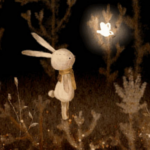

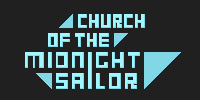

Thank you for the interview!